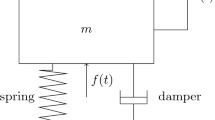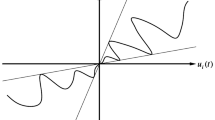Abstract
It begins with the study of damping representation of a linear vibration system of single degree of freedom (SDOF), from the view point of fractional calculus. By using the idea of stability switch, it shows that the linear term involving the fractional-order derivative of an order between 0 and 2 always acts as a damping force, so that the unique equilibrium is asymptotically stable. Further, based on the idea of stability switch again, the paper proposes a scheme for determining the stable gain region of a linear vibration system under a fractional-order control. It shows that unlike the classical velocity feedback which can adjust the damping force only, a fractional-order feedback can adjust not only the damping force, but also the elastic restoring force, and in addition, a fractional-order PD α control can either enlarge the stable gain region or narrow the stable gain region. For the dynamic systems described by integer-order derivatives, the asymptotical stability of an equilibrium is guaranteed if all characteristic roots stay in the open left half-plane, while for the systems with fractional-order derivatives, the asymptotical stability of an equilibrium is guaranteed if all characteristic roots stay within a sector in the complex plane. Analysis shows that the proposed method, based on the idea of stability switch, works effectively in the stability analysis of dynamical systems with fractional-order derivatives.
Similar content being viewed by others
References
Bagley R L, Torvik P J. On the appearance of the fractional derivative in the behavior of real materials. J Appl Mech, 1984, 51: 294–298
Bagley R L, Torvik P J. Fractional calculus—A different approach to the analysis of viscoe1astically damped structures. AIAA J, 1983, 21: 741–748
Bagley R L, Torvik P J. A theoretical basis for the application of fractional calculus to viscoelasticity. J Rheol. 1983, 27: 201–220
Bagley R L, Torvik P J. Fractional calculus in the transient analysis of viscoelastically damped structures. AIAA J, 1985, 23: 918–925
Bagley R L. Power law and fractional calculus model of viscoelasticity. AIAA J, 1989, 27: 1412–1417
Ingman D, Suzdalnitsky J. Application of dynamic fractional differentiation to the study of oscillating viscoelastic medium with cylindrical cavity. J Vib Acoust, 2002, 124: 642–645
Heymans N. Fractional calculus description of non-linear viscoelastic behavior of polymers. Nonlinear Dyn, 2004, 38: 221–231
Adolfsson K. Nonlinear fractional order viscoelasticity at large strains. Nonlinear Dyn, 2004, 38: 233–246
Koeller R C. Toward an equation of state for solid materials with memory by use of the half-order derivative. Acta Mech, 2007, 191: 125–131
Tong D K, Wang R H. Analysis of the flow of non-Newtonian viscoelastic fluids in fractal reservoir with the fractional derivative. Sci China Ser G-Phys Mech Astron, 2004, 47: 421–441
Tong D K, Wang R H, Yang H S. Exact solutions for the flow of non-Newtonian fluid with fractional derivative in an annular pipe. Sci China Ser G-Phys Mech Astron, 2005, 48: 485–495
Xu M Y, Tan W C. Intermediate processes and critical phenomena: Theory, method and progress of fractional operators and their applications to modern mechanics. Sci China Ser G-Phys Mech Astron, 2006, 49: 257–272
Podlubny I. Fractional Differential Equations. San Diego: Academic Press, 1999
Kilbas A A, Srivastava H M, Trujillo J J. Theory and Applications of Fractional Differential Equations. Amsterdam: Elsevier, 2006
Das S. Functional Fractional Calculus for System Identification and Controls. Berlin: Springer-Verlag, 2008
Monje C A, Calderon A J, Vinagre B M, et al. On fractional PI λ controllers: Some tuning rules for robustness to plant uncertainties. Nonlinear Dyn, 2004, 38: 369–381
Manabe S. A suggestion of fractional-order controller for flexible spacecraft attitude control. Nonlinear Dyn, 2004, 29: 251–268
Lazarevic M P. Finite time stability of PD α fractional control of robotic time-delay systems. Mech Res Commun, 2006, 33: 269–279
Xue D, Zhao C, Chen Y. Fractional order PID control of a DC-motor with elastic shaft: A case study. American Control Conference, 2006, doi: 10.1109/ACC.2006.1657207
Cervera J, Banos A, Monje C A, et al. Turning of fractional PID controllers by using QFT. IEEE, 2006, doi: 10.1109/IECON.2006. 348131
Wang Z H, Zheng Y G. The optimal form of the fractional-order difference feedbacks in enhancing the stability of a SDOF vibration system. J Sound Vib, 2009, 326: 476–488
Radwan A G, Soliman A M, Elwakli A S, et al. On the stability of linear systems with fractional-order elements. Chaos Solitons Fractals, 2009, 40: 2317–2328
Mohammad S T, Mohammad H. A note on the stability of fractional order systems. Math Comput Simul, 2009, 79: 1566–1576
Farshad M B, Masoud K G. An efficient numerical algorithm for stability testing of fractional-delay systems. ISA Trans, 2009, 48: 32–37
Hwang C, Cheng Y C. A numerical algorithm for stability testing of fractional delay systems. Automatica, 2006, 42: 825–831
Wang Z B, Cao G Y, Zhu X J. Stability conditions and criteria for fractional order linear time-invariant systems (in Chinese). Control Theory Appl, 2004, 21: 922–926
Chen Y Q, Ahn H S, Podlubny I. Robust stability check of fractional order linear time invariant systems with interval uncertainties. Signal Process, 2006, 86: 2611–2618
Bonilla B, Rivero M, Trujillo J J. Linear differential equations of fractional orders. In: Sabatier J, Agrawal O P, Tenreiro Machado J A, eds. Advances in Fractional Calculus. Dordrecht: Springer, 2007. 77–91
Naber M. Linear fractionally damped oscillator. Int J Differ Equ, 2010, Doi: 10.1155/2010/197020
Author information
Authors and Affiliations
Corresponding author
Rights and permissions
About this article
Cite this article
Wang, Z., Hu, H. Stability of a linear oscillator with damping force of the fractional-order derivative. Sci. China Phys. Mech. Astron. 53, 345–352 (2010). https://doi.org/10.1007/s11433-009-0291-y
Received:
Accepted:
Published:
Issue Date:
DOI: https://doi.org/10.1007/s11433-009-0291-y




